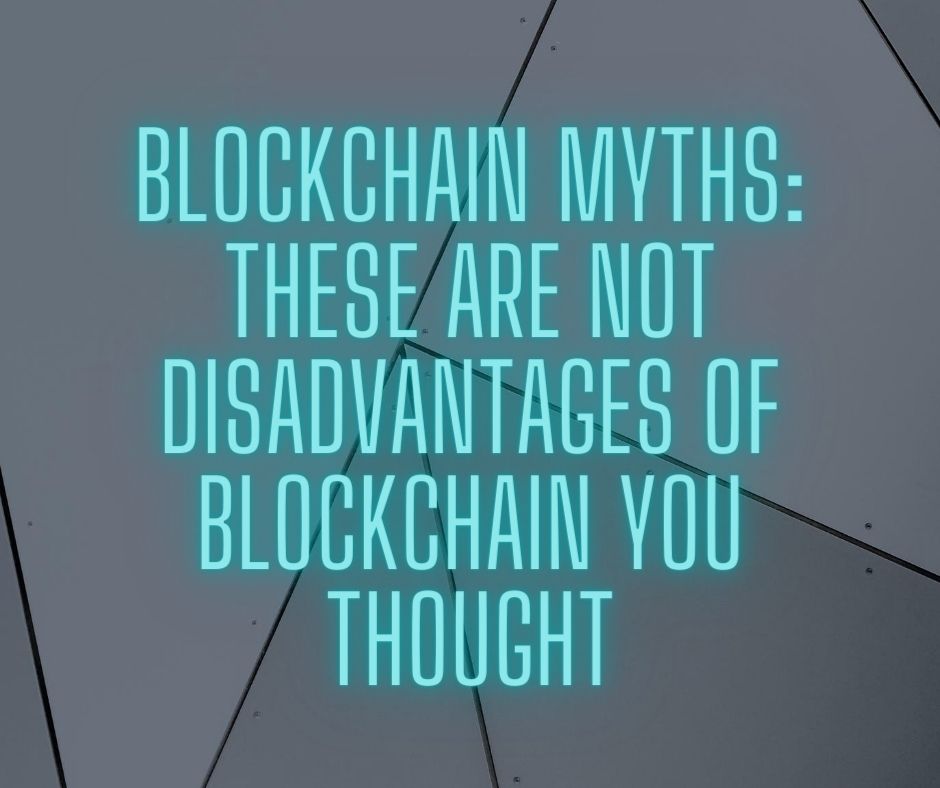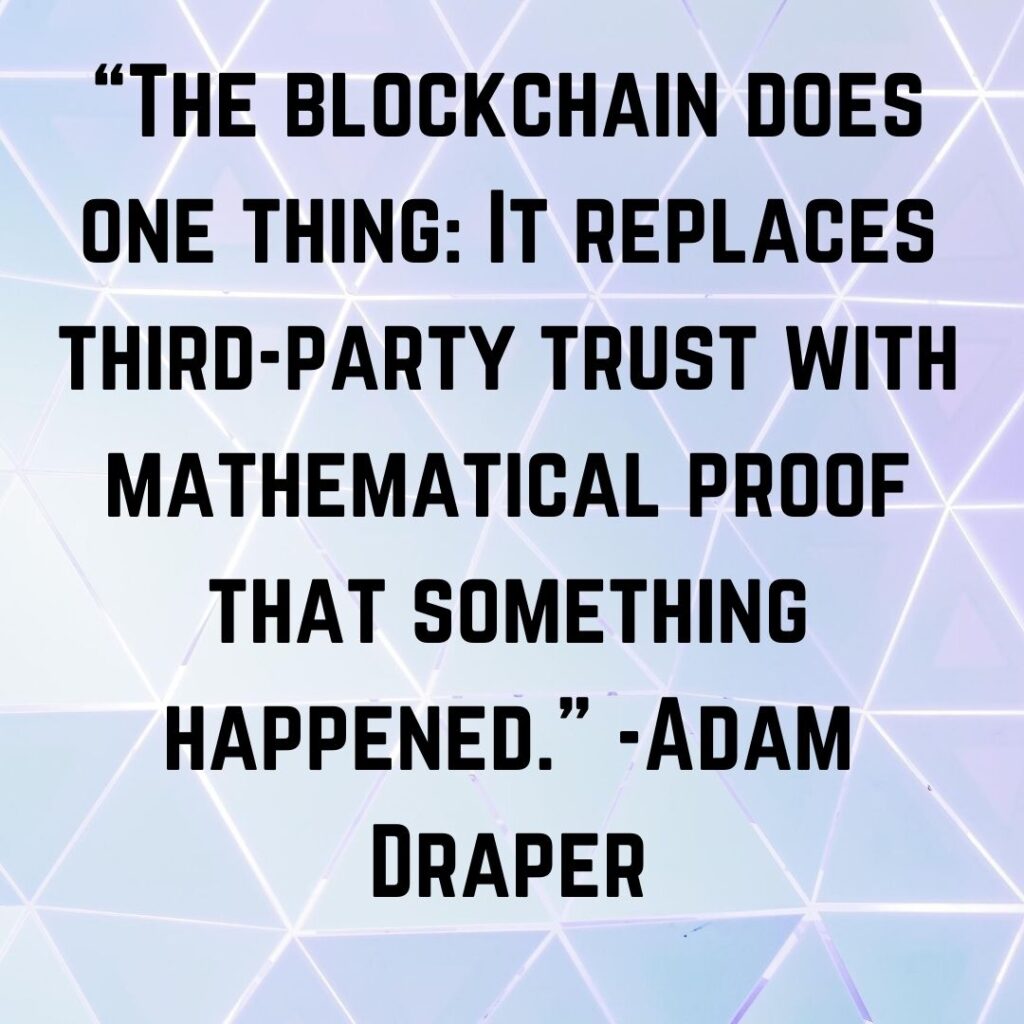Blockchain Myths: These are not Disadvantages of Blockchain You Thought
- 26 August 2020 | 1472 Views | By Abhinav Mishra

If you talk about investment options in recent years, you cannot afford not to consider cryptocurrency as an option. Bitcoin, one of the most popular cryptocurrency, has been in talks for all the reasons in the past few years, for giving meteoric rise and then a sudden crash, and for that reason you got to have heard about blockchain technology too. A lot has been said and talked about blockchain and most of it can be confusing and misinformation. So this article, we are going to talk about blockchain and the most common myths around blockchain.
What is Blockchain?
In layman’s terms, you can define blockchain as – a shared digital ledger on which every transaction is recorded. It is a digital log file that keeps online transactions secure, the transactions are duplicated and distributed across the entire network of computer systems on the blockchain. Every block which is part of the chain contains a number of transactions and every time a new transaction is added on the blockchain, a record of that transaction is added to every participant’s ledger.
The central idea of blockchain is that it is open-source meaning that anyone with a PC and with enough free storage space can download a blockchain of their choosing. To understand this better – if you have a computer with 145 GB of free space, you can head over to Bitcoin.org and download Bitcoin Core. If you have a good internet connection and bandwidth for the full blockchain, your computer will help strengthen the Bitcoin network.
You see there is a decentralized database managed by multiple participants and this is known as Distributed Ledger Technology (DLT). A distributed network is one where a number of computers are present in a different location and share a data link but a decentralized network has no direct data link between them.
How does blockchain work?
There are two ways to understand this – technical and non-technical. Assuming you are new to technology, it is better you first understand without technical details.
Let us take a scenario, where two persons, A and B, bet on the result of a football match between Chelsea and Arsenal for $100. If Chelsea wins, A gets $100. If Arsenal wins, B gets $100. To manage this transaction, there are three options in front of both:
Trust – Whoever wins, the loser will give $100 to the winner. If they are friends, it is a good way of managing the transaction but what if they are strangers, one may not easily pay the other.
Contract – Both can sign a contract that will bind one to pay if he loses. If the loser does not pay, the winner can follow a legal process which will come with a cost. For a small amount of $100, following that path won’t make sense.
Neutral third party – Both A and B give $100 each to a third party who will give the total amount to the winner. But what if the person runs away with the complete $200?
Trusting a third party should not be an option, right? This is where blockchain comes into the picture, it offers you a third option which is quick, secure, and cheap. It allows you to write a few lines of code that mention the bet logic and outcome. The program will keep the $200 and based on the result will transfer the amount to the winner.
Technical Information about Blockchain
Now let us go into the technical side. As mentioned above, each participant which is known as node maintains a copy of the blockchain data and they communicate with each other to ensure they are on the same page, known as a block. A central part of every blockchain is the process called mining. Mining relies on hashing algorithms. Bitcoin uses the SHA-256 algorithm and it takes an input of any length and generates an output that will always have the exact same length. The output produced is called a “hash” and is always made of 64 characters (256 bits).
Can Blockchain be hacked?
A particular input will always give the same output, no matter how many times you repeat the process. If you change the input even slightly, the output will be completely different. The hash functions are mostly one-way hash function meaning it is almost impossible to calculate what the input from the output was.
Once a transaction is sealed into a block and added to the Blockchain, changing it is close to impossible. You will need to reverse engineer the hashed block and make a change to the transaction data contained within. The tougher part is you will have to do this simultaneously on at least 51% of the copies of the ledger held on different nodes. Since this is impossible to achieve, it is practically not possible to hack a Blockchain.
What is Blockchain’s example?
Let us take an example of financial institutions – your bank. Your bank works 5 days a week and only during business hours. If you deposit a cheque on Friday evening, you will not get the amount credited in your account before Monday. In some cases, it takes 1 to 3 working days because of the huge volume. Blockchain on the other hand never sleeps. So once blockchain is integrated into the traditional banking system, you can see your transactions processed in as little as 10 minutes – the time it takes to add a block to the blockchain.
Why do we need Blockchain?
With the use of blockchain technology, people around the world can be free from the constant dependence on banks and other middlemen. It will also allow you not to be at the mercy of businesses that collect and hold on to your sensitive information. Since every transaction is visible to users worldwide, using blockchain, transparency between consumers and businesses will rise to unprecedented levels.
Since the technology is impossible to hack, breaches and thefts of huge amounts of social security numbers, or credit card numbers would be a thing of the past, and consumers and businesses could make transactions with true security.
What are Blockchain myths?
Blockchain and cryptocurrency are used primarily for criminal purposes – Most people think, Bitcoin works only in the dark web and is favorite among criminals due to anonymity. However, the reality is completely different, the fact that blockchain is easier to track than physical cash, it is used in forensic analysis for governmental bodies to crack down on illegal activities such as money laundering and drugs.
1. Blockchain will remove all middleman
Most people think blockchain can eliminate banking intermediary between transacting parties. Yes, some intermediaries may be completely eliminated. However, the extent of elimination it brings will depend on the specific application of a type of blockchain implementation. In some cases, blockchain will still need to work with existing intermediaries, although their function and role may change.
2. All Blockchain systems are public platforms
By definition, blockchain is a public platform with nodes spread on a global scale, and every participant is able to view every transaction. However, this is completely inaccurate as blockchain systems are able to support different layers of privacy within groups of nodes or even organization.
3. Blockchain is all about money
The first blockchain was used for the digital currency Bitcoin, however, the potential of blockchain technology is far beyond finance and money. Today blockchain is used on a number of services like smart contracts, cloud storage, voting systems, digital identity solutions, supply chain, and even aircraft safety. The only reason why most people may think that blockchains are all about money is perhaps that Bitcoin is the most popular and most discussed.
4. Only big companies can use blockchains
Many people think you need a huge setup for blockchain which is only possible for large corporations, however, non-corporate or small companies can also benefit from the Blockchain. One of the advantages of blockchain is that it can be scaled to fit the needs of the user. Therefore a wide variety of individuals, business groups, and non-business users can take advantage of it. At present, only big firms are working on the blockchain technology.
5. Blockchains expose your private data
In the case of public blockchains, most people think that all transactional details are out in the open and there is no privacy. The statement is far from the truth. The only aspect of the transaction that is in the public domain is the hash and the transaction amount. When you compare this with your traditional financial institution, they have every single detail of you and your family at their fingertips. The belief is probably popular because of the word ‘public’ which is often associated with blockchain.
6. Blockchain Transactions Are Anonymous
Many people are under the false assumption that all blockchain transactions are anonymous. Blockchain is a public ledger that tracks how much was sent from one address to the next address. Many government organizations have established relationships with major exchanges to complete the mapping of the address to the owner.
7. Blockchain is just a Storage Mechanism
Blockchain is not about storing data. Many people believe that they can store documents on a blockchain but blockchain only contain the information that a specific document exists. Data, such as spreadsheets or documents can be stored in data lakes, which can only be accessed by the owner of the documents.
Who are the biggest Blockchain companies?
As mentioned above, blockchain can be used by any company and from any sector. Here are some of the biggest companies using blockchain:
- IBM
- Gemini
- Oracle Blockchain cloud service
- Amazon Web Services
- Microsoft Azure
Is Blockchain the future?
Blockchain came into existence more than a decade back and we can stay blockchain developments have not been as fast as many might have expected. However, as they say, slow and steady wins the race. The growth and adoption have been slow but the number of areas the blockchain is being used now makes it the technology of the future.
With big players, innovators, and governments across the world, all currently betting on it, blockchain simply can’t be a fad.
Check out these interesting articles to explore more about Blockchain:
Is Blockchain Technology Safe and Beneficial for Banking Sector??










